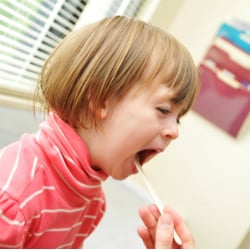
The common cold
20 July 2011
The season of colds and upper respiratory infections (URIs) will soon be upon us. A variety of viruses — rhinovirus, adenovirus, coronavirus, parainfluenza virus, respiratory syncytial virus (RSV), metapneumovirus and influenza — inflict a self-limiting condition we call the common cold. Anywhere from 30- 80% of URIs at all ages are attributable to rhinovirus, and there are over 100 different serotypes.
Proven adverse effects
In Canada, the incidence increases in the fall and remains high throughout the winter. The younger the child, the higher the frequency — 6-10 URIs per year, especially for those in daycare. Symptoms include congestion, nasal stuffiness and discharge, watery eyes, sneezing, itchy nose, sore throat and cough. Complications may involve otitis media, sinusitis and pneumonia.
It’s important to recognize that sinus congestion is not an indication for prescribing antibiotics. The clinician must differentiate between a viral rhinosinusitis (common in children) and a bacterial one (rare).
This point is well made in the CT scans of the sinuses during a proven rhinovirus infection that cleared spontaneously. Most physicians are inundated with requests to “do something,” and the temptation is to prescribe an antibiotic and/or recommend an over-the-counter (OTC) medication. These commonly contain various combinations of antihistamines, cough suppressants (codeine, dextromethorphan, hydrocodone), expectorant, nasal decongestant and sometimes acetaminophen or ibuprofen.
Overprescribing of antibiotics has furthered bacterial resistance, now a major concern. According to guidelines, there’s little proven efficacy for over-the-counter medications, and they may even be dangerous for young children. In fact, the U.S. Centers for Disease Control (CDC) recently reported that in 2004-5 alone, 1,519 kids under the age of 2 were treated in emergency rooms for adverse effects. The deaths of 3 infants under 6 months were all linked to high blood levels of pseudoephedrine, a drug often found in OTC medications. We don’t yet know what dosages are tolerable, and the U.S. Federal Drug Agency issued a warning on 15/8/07.
If the duration of the illness exceeds the usual course of 7-10 days or a high fever suddenly appears after a few days, have the child re-examined to rule out a bacterial infection. Adequate hydration is important, and particularly rest, something often ignored because of the harried lives of parents and children alike. If necessary, an antipyretic/analgesic can be given. Nasal lavage with a commercial saline solution is simple and quite efficacious. Parents can be taught to gently remove secretions from an infant’s nose with a suction bulb. A lubricant gel or petrolatum may soothe dry, irritated nasal mucosa.
Though unproven, a humidity level of 35-40% in the room might help.
Reassurance soothes
It takes time and patience to explain the self-limiting course of these infections to overwrought parents. Benign neglect, follow-up and reassurance are probably the best therapy, particularly for babies under the age of 2.
By Dr. Richard Haber
